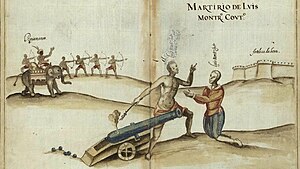Capture of Truk
| Capture of Truk islands | |||||||
|---|---|---|---|---|---|---|---|
| Part of Daxian Polynesian Wars | |||||||
 Battle between Daxian and Emirate fleets, the less numerous Emirati ships on the left trying to close with the enemy | |||||||
| |||||||
| Belligerents | |||||||
| Emirate of Truk | Daxia | ||||||
| Commanders and leaders | |||||||
| Akhmat Tidore IV | Marquis Shenbao | ||||||
| Strength | |||||||
|
8,500 men 35 ships |
10,700 Daxians 50 ships | ||||||
| Casualties and losses | |||||||
| thousands | thousands | ||||||
The Capture of Truk was the conquest of the independent Emirate of Truk by a military force of Daxia's Qian dynasty in 1676. Part of the Daxian filibuster wars, the capture of Truk was long desired for its valuable position on the Southern route and close to the Kindreds, its saltpeter mines and to bring to heel a troublesome independent polity. The Truk archipelago is composed of two large islands (Iman and Hutau) and four smaller ones (Sinta, Chunma, Anako and Parapo).
Background
The islands of Truk has been inhabited by polynesian peoples since at least 600 BCE, with settlers possibly arriving from Vallos. The polynesian people of Truk developed in isolation for hundreds of years, limiting their sailing to nearby archipelagos. In the year 1251 an Islamic mystic by the name of Sayed Ali Qumi arrived by accident on the islands with a few companions, their ship having sunk in a storm. Qumi proceeded to successfully spread Islam to the people of Truk who were so impressed with the tales of martial conquests by Muslim armies that they agreed to convert. The King of Truk of the day adopted the islamic first name of Akhmat to signal his new piety and began to style himself as emir. Shortly after Syed Ali Qumi departed for the east, his original destination. Another gift they had been left with was the secret of producing iron, something the people of the new Emirate took to quickly for Qumi also left them with a warning: that the seas were full of infidels and they would need to protect what was theirs. It is believed by modern scholars that Qumi could have originally been from what is now Rusana. Energized by their new faith, the elites of the new Emirate of Truk looked to spread to neighboring islands. Two years of rigorous campaigning saw the nearby atolls and reefs conquered by Akhmat Tidore and its backward inhabitants incorporated into the ummah. Unlike mainstream conquests in Audonia the Muslims of Truk left no room for dhimmis to exist, forcing every tribe to convert or be destroyed; by the 1270's the islands were uniformly Muslim and Islam was the official religion of the state.

Over the next two hundred years the emirate would become a local trading power, welcoming merchant expeditions from Daxia, Caphiria, the Loa and Caphiria. Truk's wily rulers managed to tiptoe around the various powers and avoided committing to any one side for too long, making Truk an important component of the southern route and the Audonia-Sarpedon trade and taking advantage of the cultural and economic exchanges. Beginning in 1642 Emir Mahmud Tidore II agreed to a loose compact with Daxia to counter encroachments by the Caphirian Imperium. Mahmud allowed the Daxians to build a fort on the island; the emirate's forces also received some shipments of weapons such as muskets to increase their battle worthiness. In time the Daxians would station a permanent representative on Truk to oversee relations with the emirate and steer its pro-Daxian stance. In return for their protection, Mahmud sold them pearls, saltpeter, sago(a type of starch used for bread) and cassava at greatly discounted rates. Mahmud's son, Akhmat opposed his father's pro-Daxian policies and anti-Daxian courtiers and officials banded around him; creating a powerful clique. Akhmat resented non muslims having such influence over the affairs of the emirate and considered the discounted prices on goods sold to Daxia ruinous to local finances. Emir Mahmud fell gravely ill during the winter of 1674; prompting the prince to launch a coup. Akhmat and his loyalists in the royal guard seized the palace complex and produced a fatwa by the Grand Mufti deposing Mahmud in favor of his son, Mahmud was confined to his sick room. When he got wind of the events taking place, the Daxian representative marched to the palace and demanded an audience with Akhmat only to be slapped by the guards and threatened into leaving. A passing Daxian merchant took an account of what transpired with him back to the port of Rakin (present-day Rakahanga). The insult to their envoy and the overthrow of a sympathetic ruler would prompt a heavy handed response from the Qian court in the form of a large force commanded by the governor of Australis, Marquis Shenbao.
Conquest
Finally receiving the Daxian ambassador, Akhmat was told in no uncertain terms that he must pay an indemnity for his insults then step down and restore his father to his throne; the emir summarily rejected these demands and had his Grand Mufti declare a jihad to defend the islands. While the Daxians were making their preparations, the new emir was anything but idle. Akhmat called in loans from various Sarpedon-based bankers and used the funds to expand his army and contract the Caphiriann mercenary group known as Barbari Gigantes (the Bearded Colossi) who fought in hollow squares (known in their language as tercios) of pikemen surrounding musketmen; Akhmat used these troops to reduce the Daxian fort in four weeks. The proclamation of jihad and offers of lower taxes enticed the saltpeter princes (powerful vassals who controlled the saltpeter mines) who normally chafed under the emir's control to wholly support Akhmat. The Emir's forces amounted to eight thousand men including his mercenaries, fifteen locally produced cannons and thirty five ships, mostly trade xebecs adapted with gun ports.

Marquis Shenbao and his force departed Rakin on early April and found favorable weather for most of their trip, losing a single ship who crashed into a reef on approach to the Truk islands, altough most of the men were able to evacuate it. The Emirati fleet attempted to sail out to contest a landing but the xebec's found themselves hopelessly outgunned and outranged, only a few were able to get close enough for boarding actions but withering close range cannon fire saw them ultimately repulsed. Rather than lose his entire fleet Akhmat ordered it to disengage and sail away to the bay of Hutau. Shenbao landed his forces on the main island of Iman, ignoring the smaller islands of Anako and Chunma. Daxian scouting parties were ambushed frequently and Daxian and Emirati forces clashed in the Battle of Pasai, an indecisive engagement where the Daxians got the better of Akhmat but the Caphirian mercenaries were able to cover his retreat efficiently with their pike squares.
Despite constant harassment and night attacks, Shenbao pushed his army to the gates of Imarli, capital of the emirate where another battle took place. Akhmad released his trump card on the battlefield, six armored elephants bought from Takatta Loa. The creatures charged the left flank of the Daxian battle lines, trampling and scattering many of their polynesian levies and for a moment appeared unfazed even by gunfire and cannonfire. In response the Daxians set a herd of pigs coated in resin and specifically brought for this purpose on fire, herding them towards the rampaging elephants which became frigthened by the squeals of the dying pigs. The elephants turned around and in their panick ran amok into their own lines, throwing the Muslim army into disarray and putting most of it to flight. As before the Caphiriann tercios stood their ground but now finding themselves abandoned by their allies, repeated cannonades tore through their ranks until they also broke and ran. The Battle of the Gates of Imarli was a decisive victory for the invaders scattering most of the royal army and forcing Akhmat and his court to flee the capital. The Emir fled east to his diminished fleet and sailed to Hutau where he hoped to convince his vassals there to raise more men for him. Marquis Shenbao entered Imarli on July 1675 to a city ransacked by fleeing officials and looted by the Caphirians who stole as much loot as they could in payment before retreating to their own ships and departing.
The Daxians found the ailing Mahmud still in the palace and promptly had him declared emir by a new grand mufti. They also had him secretly declare the Daxian emperor as 'rightful heir and protector' of the emirate and promises of respect for the religion of the people were made. Akhmata Tidore was declared an outlaw and siding with him was 'irreligious'. While the Daxians restored order on Imarli and prepared to cross over to Hutau, Akhmat fought a small war against the saltpeter princes who correctly guessed that his days were numbered and did not wish to be caught in his downfall. The fallen emir eked out a marginal victory over them on September after he convinced Wali Tahir Megat to betray them mid-battle after promising to marry his daughter. The saltpeter princes from this point on do their best to deny supplies to Akhmat and force him into long sieges which his forces cannot sustain with ease while they waited for the Daxians to arrive. Finally at the onset of winter the Daxians landed their forces on Hutau and rendezvoused with the island's magnates and their forces, quickly retaking the few villages under Akhmat's control and pursuing him into the interior. His forces were finally cornered at the Muda groove and forced to give battle, a one sided struggle that saw his ragtag army utterly destroyed. To spare his father having to order it, Akhmat Tidore was executed by the Daxians immediately after the battle by rolling him up inside a carpet and having horses trot over it. His body was returned to Imarli and despite his rebellion the Daxians allowed him to be laid to rest in a mausoleum and in accordance with islamic burial rites.
Aftermath
Emir Mahmud Tidore lived only for another two years, upon which time Daxia made good on their arrangement with him and took possession of the archipelago. While for the first fifty years the governors were all Daxians, eventually local muslim notables began to be chosen for the position. Truk was afterwards given wide latitude to take care of its internal affairs, freedom not seen elsewhere in the empire. This autonomy continues in the modern day as the Truk archipelago has maintained a high degree of autonomy and is even ruled by a distinct local party. There was moderate settlement of Daxians in the following centuries, especially in coastal areas and around military strongpoints. The moderate intermixing of locals with Daxians can be seen today with people of mostly polynesian descent but also possessing distinctly Daxian epicanthus folds.